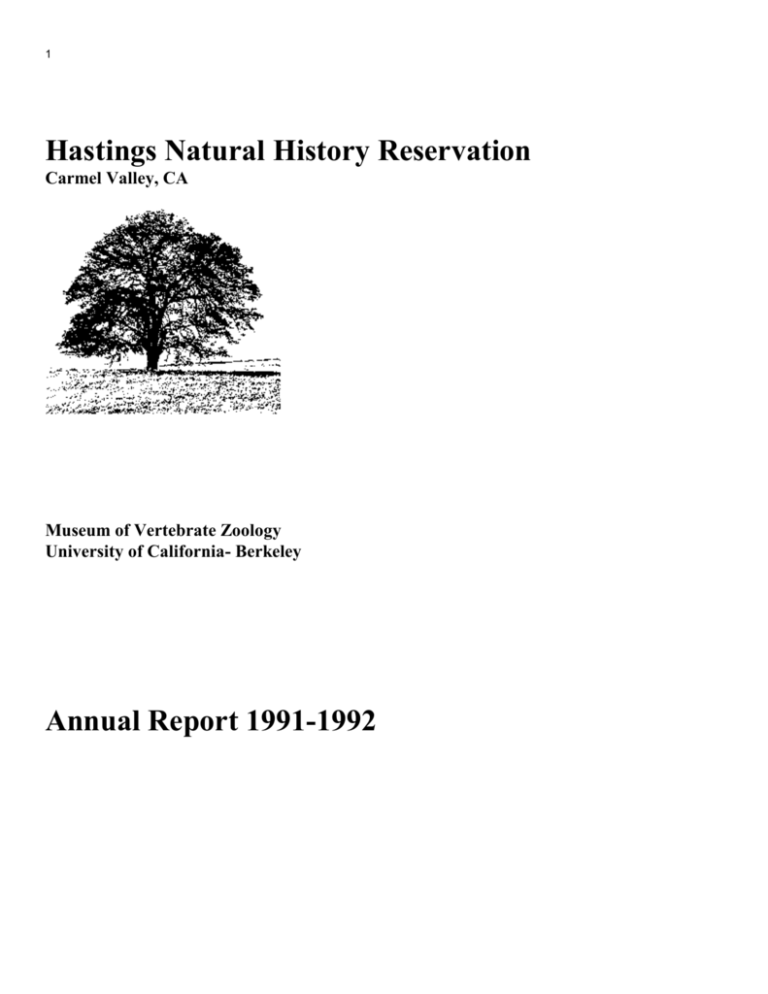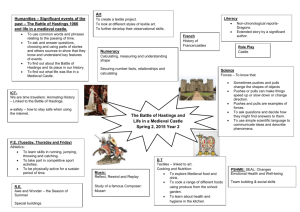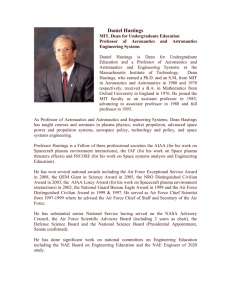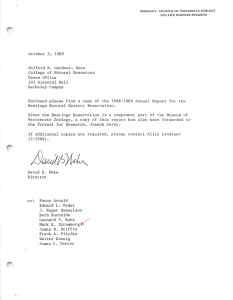1991 - Hastings Natural History Reservation
advertisement

1 Hastings Natural History Reservation Carmel Valley, CA Museum of Vertebrate Zoology University of California- Berkeley Annual Report 1991-1992 2 By: Dr. Mark R. Stromberg, Hastings Professor Frank A. Pitelka, Museum of Vertebrate Zoology Betty Holland, Museum of of Vertebrate Zoology Major Research Programs As a biological field station of the Museum of Vertebrate Zoology (MVZ), resident MVZ staff and research associates conduct the majority of the research program at Hastings. Researchers from other institutions from across the United States and several foreign countries are working at Hastings as well. Hastings continues to support internationally significant academic field research. In addition, several research projects are underway to meet the practical needs of the local and state community. Dr. Walter Koenig (Hastings, MVZ), his students, and colleagues continue to explore the social behavior and ecology of the acorn woodpecker. Dr. Koenig’s work on acorn woodpeckers is funded by the National Science Foundation. Dr. Mark Stanback, an NSF postdoctoral fellow from the University of Washington, is studying hormone levels in these birds as they go through elaborate breeding behavior. Dr. Koenig added to a 20 year data base on the lineages of breeding groups and is investigating degrees of relatedness with DNA fingerprinting techniques. Six undergraduate field assistants worked seasonally, full time under the supervision of Dr. Koenig. Several were supported by the National Science Foundation program, “Research Experience for Undergraduates”. During this last year, Dr. Koenig and his colleagues wrote several peer-reviewed publications from research on the acorn woodpeckers (below). Dr. Koenig, in association with Dr. Mark Stromberg (Hastings, MVZ) and Dr. Brad Shaffer (UCDavis, Zoology), initiated a study of the endangered California Tiger Salamander. Presence of this rare salamander has postponed several suburban developments; even the most elementary aspects of the life history of this salamander are unknown. Owners of the adjacent Oak Ridge Ranch (Jim and Rebecca Kirk) along with the manager of Oak Ridge, Tim Curran, allowed Hastings researchers to fence an ephemeral pond (Blomquist Pond) to capture and study these salamanders. During 1992, we marked about 1,000 individual salamanders at one pond, and we documented some basic biological information which can be used in mitigation planning elsewhere in California. Limited funds from the California Department of Fish and Game supported this salamander research. Dr. Koenig and colleagues continued to work with funds from the Integrated Hardwood Range Management Program (State of California) to determine environmental factors which influence acorn production in coastal oaks. Information from 15 years of acorn production from hundreds of trees is of great interest to wildlife managers and foresters working to restore or manage oaks in coastal California. Dr. Janis Dickinson (Hastings, MVZ) is studying patterns of breeding behavior in western bluebirds. Funds from NSF have allowed Dr. Dickinson to hire five undergraduate field assistants for seasonal, full time research. Working at the MVZ labs, Dr. Dickinson developed techniques to use DNA fingerprinting to analyze the breeding system of western bluebirds on Hastings and adjacent Oak Ridge Ranch. 3 Dr. Mark Stromberg (MVZ, Hastings), working with Dr. John Menke (UC-Davis, Agronomy and Range Science), David Amme (California Native Grass Association) and Paul Kephart (Elkhorn Ranch) continued a five year study of native perennial grasses in grazing systems. Funding from PG&E’s Excellence in Wildland Research complimented funds from the Carmel Ranch Company. Experimental plantings were fenced, grazed, and studied in detail. Posters and lectures were presented to local and state organizations working to restore native grasses in commercial grazing operations and in state and federal parks. Karen Rasmussen joined this is research program as a graduate student under Dr. Menke with her doctoral research focused in Carmel Valley. Dr. Jenella Loye (UC-Davis, Entomology) was a resident researcher during this year. Dr. Loye monitored western bluebird nests on Rana Creek Ranch and Rancho San Carlos, collecting insects which parasitize nestling birds. Dr. Loye’s work is funded by the National Science Foundation. Dr. Tom Nash (Arizona State University, Botany) and Dr. Bill Schlesinger (Duke University, Botany) continue to support their resident graduate student, Jean Knops, in the last year of a three year project on water and soil nutrients in lichens hanging from Hastings’ blue oaks. Jean spent the year collecting rainfall, soil and litter samples for processing labs at Duke and ASU. The National Science Foundation supports the lichen research. Dr. Gordon Frankie (UC-Berkeley) and his graduate student John Barthell, continue to monitor Carmel Valley for Africanized bees, which are expected to arrive in 1993-1994. John Barthell completed his doctoral dissertation on the effects of introductions of European earwigs on native solitary bees. Dr. Barthell continued his observations of bees at Hastings in a new position at the UC-Davis Bee Lab. Dr. Jim Griffin (Hastings MVZ) continued to work with Pam Muick, a graduate student under Dr. Joe McBride, UC-Berkeley, Forestry. Pam completed her doctoral dissertation based on field work at Hastings on evaluating techniques to plant various species of coastal oaks. Pam co-authored a significant book furthering public education on oaks in California. Dr. Muick’s book featured brief articles from three resident Hastings researchers. Research use of Hastings continues to increase for a total of 5,977 users-days. Resident staff have reached a recent peak of four, including Dr. Walter Koenig, Dr. Janis Dickinson, Dr. James Griffin and Dr. Mark Stromberg, for a total of 1,825 user-days. Frank Sala was accepted by the Museum of Vertebrate Zoology as a research associate at Hastings. We have reached housing and laboratory capacity and additional research projects must be carefully evaluated. Total user-days have increased (Figure 1) as have the total number of users. Hastings continues to attract an increasing number of graduate students, faculty and professionals, and undergraduate students (Figure 2). Public Events Hastings’ annual Field Day was held on May 3, 1992. Invited guests were treated to a barbecue lunch with hamburgers provided by our neighbors at Rana Creek Ranch. Resident and visiting researchers made brief presentations, and about 85 neighbors and visitors shared a beautiful spring day at Hastings. 4 Dr. Mark Stromberg hosted a group of 25 professional natural resource managers from state and federal agencies working with native perennial grasses. With Paul Kephart (Elkhorn Ranch, Moss Landing), the group toured relict native grasslands and experimental research plantings in Carmel Valley during a two day workshop in May. Education Program Hastings does not offer lectures or classes. However, instructors from 13 institutions brought classes to Hastings. A total of 254 persons used Hastings for a total of 305 user-days of instruction (Figure 3.). All of these groups used various housing facilities at Hastings, primarily the Robertson House which has 10 beds. Groups of up to 25 have used the Robertson House when some users elect to sleep in tents. Significantly more class instruction could be supported by Hastings. During the fall and spring semesters, the Robertson House is now available for groups or field trips. It’s isolation from the headquarters and most research activity mean minimal disturbance to ongoing research programs. As the Bunkhouse can now house field assistants during the busy spring and summer research season and visitors during the winter, the Robertson House is available for groups. It is presently used by classes only about 10% of the time it is available during the winter and spring semesters. Several groups and classes have expressed interest in using Hastings, but we lack a winterized classroom. Increased use of the Robertson House would be possible if a classroom/group kitchen facility were built on the site available and adjacent to the Robertson House. Facilities Development Fanny Arnold generously donated funds to allow us to proceed with a replacement for the three bedroom “Bunkhouse” in the headquarters area. Architectural drawings were prepared early in 1992 and ground was broken by Daniels and House Construction on May 26. Completion is scheduled for early September, 1992. The bunkhouse is a modern, winterized, energy-efficient house with three bedrooms, each with a bunk bed. It is designed to allow residents to live relatively independently with a modern kitchen, bath and community laundry facility. Again with funds from Fanny Arnold, Mark Johnson, Hastings Reserve Steward, added a modern restroom to the septic system installed two years ago with the Hasting Lab. Adjacent to the office area, this facility greatly enhances our ability to host groups and visitors to the headquarters area. Mark also installed new entry signs and smaller signs to direct users in the reservation road system. Mark Johnson directed a Gabilan crew from CDF who rebuilt over 4 miles of steel post and barbed wire fencing along Carmel Valley Road. A contractor was hired to replace the original roofs on the School House garage and the small office at the School House, Betty’s Lab. Progress was made in the planning and design phase of the reconstruction of the water supply system at Hastings. Funding ($105,000) was identified from several sources; the Museum of Vertebrate Zoology (Hastings Endowment), Natural Reserve System and UC Campus; office of the Dean, College of Agriculture and Natural Resources. Planning continues with the Office of Planning and Design at the UC Berkeley campus. 5 Cooperative Land Use Agreements with several Carmel Valley ranches have added significantly to the ability of biologists at Hastings to conduct biological research. The Carmel Ranch Company continues to provide significant funds, grazing impact and access for our grassland research. We appreciate the help from Dan Lufkin, Jill Curran, Sam Jurey and all the others at Carmel Ranch Company. Rana Creek Ranch provided access to land for bluebird boxes and experimental planting of native grasses. We would like to thank Kent Heneks and Brian Heneks for their help in arranging access and controlled grazing on experimental sites. Rancho San Carlos provided archival storage boxes for our insect collection and access to land for bluebird nest boxes and sampling sites for research on lichens. We would like to thank Jeff Froke and the management group of Pacific Union Company’s Rancho San Carlos for their continued interest and support for our research programs. Oak Ridge Ranch continues to provide support in many way, including critical access to research plots which we have had in continuous observation, in some cases, for nearly 20 years. Permission to work on Oak Ridge allows access to the homes of many well known families of acorn woodpeckers and western bluebirds. Our thanks go to the owners, Jim Kirk and Rebecca Kirk, and to Tim Curran and Roger Allen. We particularly appreciate the cooperative agreement with Oak Ridge Ranch allowing us to study Blomquist Pond and Laguna Conejo Pond. Hastings has never had access to an aquatic habitat. Thus, for 50 years we have not been able to study some of the most common amphibians and wetland animals in Carmel Valley. With access to Blomquist Pond, many new animals studies can now be considered. Publications- Books Pavlik, B. M., P. C. Muick, S. Johnson, and M. Popper. 1991. Oaks of California. Cachuma Press, Los Olivos, CA. Publications- Papers Dickinson, J.L. 1992. Scramble competition polygyny in the milkweed leaf beetle: combat, mobility, and the importance of being there. Behav. Ecol. 3:32-41. Koenig, W. D. 1991. Levels of female choice in the white-tailed skimmer Plethemis lydia (Odonata: Libellulidae). Behavior 119:193-224. Koenig, W. D. 1991. [Review] Food Hoarding in Animals, by S. B. Vander Wall. Journal of Evolutionary Biology 4:690. Koenig, W.D.1992. [Protecting a territory of stored acorns: the acorn woodpecker]. Animals on Earth (Ashai Encyclopedia, weekly) 29:137-139 [In Japanese] 6 Koenig, W. D., P. A. Gowaty, and J. L. Dickinson. 1992. Boxes, barns, and bridges: confounding factor or exceptional opportunities in ecological studies. Oikos 63:305-308. Koenig, W. D., W. J. Carmen, M. T. Stanback, and R. L. Mumme. Determinants of acorn productivity among five species of oaks in central coastal California. Pp. 136-142. In Standiford, R. B. 1991. Proceedings of the symposium on oak woodlands and hardwood rangeland management. October 31November 2, 1990; Davis, California. Gen. Tech Rep. PSW-126. Berkeley, CA: U.S. Forest Service. 376p. Koenig, W.D., M.T. Stanback, P. N. Hooge and R. L. Mumme. 1991. Distress calls in the acorn woodpecker. Condor 93:637-643. Koenig, W.D., F. A. Pitelka, W. L. Carmen, R. L. Mumme, and M. T. Stanback. 1992. The evolution of delayed dispersal in cooperative breeders. Quarterly Review of Biology 67:111-150. Knops, J. M. H., T. H. Nash, V.L. Boucher and W. H. Schlesinger. 1991. Mineral cycling and epiphytic lichens: implications at the ecosystem level. Lichenologist 23:309-321. Marchessault, L. and P. Ewald. 1991. Effect of territory quality on intrusion rate in non-breeding hummingbirds. Behav. Ecol. Sociobiol. 28:305-308.[Field facilities, lab, housing provided] Muick, P. Effects of shade on blue oak and coast live oak regeneration in California annual grasslands. Pp. 21-24. In Standiford, R. B. 1991. Proceedings of the symposium on oak woodlands and hardwood rangeland management. October 31-November 2, 1990; Davis, California. Gen. Tech Rep. PSW-126. Berkeley, CA: U.S. Forest Service. 376p. Mumme, R. L. and W.D. Koenig. 1991. Explanations for avian helping behavior. Trends in Ecology and Evolution 6:343-344. Plumb, T. R. and B. Hannah. Artificial regeneration of blue and coast live oaks in the central coast. Pp 59-80. In Standiford, R. B. 1991. Proceedings of the symposium on oak woodlands and hardwood rangeland management. October 31-November 2, 1990; Davis, California. Gen. Tech Rep. PSW-126. Berkeley, CA: U.S. Forest Service. 376p. Ribble, D.O. 1991. The monogamous mating system of Peromyscus californicus as revealed by DNA fingerprinting. Behav. Ecol. Sociobiol. 29:161-166. Ribble, D. O. 1992. Lifetime reproductive success and its correlates in the monogamous rodent, Peromyscus californicus . J. Animal Ecology 61:457-468. Rice, K. J, D. R. Gordon, J. L. Hardison and J. M. Welker. Intraspecific phenotypic variation and ecological genetics of blue oak Quercus douglasii. Pp.59-63. In Standiford, R. B. 1991. Proceedings of the symposium on oak woodlands and hardwood rangeland management. October 31-November 2, 1990; Davis, California. Gen. Tech Rep. PSW-126. Berkeley, CA: U.S. Forest Service. 376p. 7 Stacey, P. B. and W. D. Koenig. 1991. Cooperative breeding in the acorn woodpecker. Pp. 95-106 in Behavior and Evolution of Birds (D.W. Mock, ed.) W. H. Freeman, San Francisco. Stanback, M.T. 1991. Autumnal breeding in the scrub jay. J. Field Ornith. 62:94-96. Stanback, M. T. 1991. A re-assessment of avian food caching. Bird Behaviour. 9:1-6. Stanback, M.T. and W. D. Koenig. 1992. Cannibalism in birds. Pp.277-298 in Cannibalism: Ecology and Evolution Among Diverse Taxa. M. A. Elgar and B. J. Crespi, eds. Oxford University Press, Oxford. Thorpe, R. W., G.W. Frankie, J. Barthell, D. Gordon, L. Newstrom, T. Griswold, J. Schmidt and S. Thoenes. 1992. Long term studies to gauge effects of invading bees. Cal. Ag. 46:20-23. [J. Barthell resident] Presentations Dickinson, J. L. February, 1992. “Infidelity and mate sharing: it’s all in the DNA” Invited Lecture, University of Santa Clara, Sigma Xi Lecture, Santa Clara, CA. Dickinson, J. L. March, 1992. “Scramble competition polygyny and mate guarding in the blue milkweed beetle”. Invited Lecture, Dept. of Integrative Biology, U.C. Berkeley. Dickinson, J. L. December, 1992. “Cooperative breeding in the western bluebird”. Museum of Vertebrate Zoology, University of California, Berkeley, CA Koenig, W. D. August, 1991. “Competition and restraint among joint-nesting acorn woodpeckers”. Annual Meeting, American Ornithologists’ Union, Montreal, Canada Koenig, W. D. October, 1991. “Competition and restraint among joint-nesting acorn woodpeckers”. Department of Zoology, Arizona State University, Tempe, Arizona. Koenig, W. D. January, 1992. “Competition and restraint among joint-nesting acorn woodpeckers”. Department of Zoology, University of California San Diego, La Jolla, CA. Koenig, W. D. January, 1992. “Competition and restraint among joint-nesting acorn woodpeckers”. Department of Zoology, Simon Fraser University, Vancouver, B.C. Koenig, W. D. February, 1992. “Competition and restraint among joint-nesting acorn woodpeckers”. Museum of Vertebrate Zoology, University of California, CA. Koenig, W. D. April, 1992. “Competition and restraint among joint-nesting acorn woodpeckers”. Department of Avian Biology, University of California, Davis, CA. 8 Koenig, W. D. June, 1992. “Dispersal, philopatry, and detectability in birds and mammals”. Annual Meeting, American Society of Naturalists/Society for the Study of Evolution, Berkeley, CA. Koenig, W. D. June, 1992.“Dispersal, philopatry, and detectability in birds and mammals”. Annual Meeting, Cooper Ornithological Society, Seattle, WA. Stromberg, M. R. March, 1992. “Central Coastal California Perennial Grasses: Relicts and Restoration”. Invited Seminar, Pacific Gas and Electricity, Excellence in Wildland Research Program. PG&E Research Center, San Ramon, CA. Stromberg, M. R. May, 1992. “Native Bunch Grasses in Carmel Valley: Relicts and Restoration”. Invited Seminar, First Annual Education Symposium, California Native Grass Association. David Packard Elkhorn Ranch, Moss Landing, CA. Stromberg, M.R. May, 1992. “Mammals in Carmel Valley”. Monterey County Lyceum. Rancho San Carlos, Carmel Valley, CA Theses Completed Muick, P. 1992. Factors influencing regeneration of coastal live oak Quercus agrifolia, blue oak Q. douglasii and valley oak Q. lobata in California. Doctoral Dissertation, Univ. of California, Berkeley. 193 pp. Barthell, J.F. 1992. Habitat heterogeneity, invaders, and the population dynamics of some oak forest solitary bee communities. Doctoral Dissertation, Univ. of California, Berkeley. 153 pp. 7000 6000 B 5000 B B 4000 B 3000 2000 B B B B B 81-82 82-83 83-84 84-85 85-86 B 86-87 B 1000 0 87-88 88-89 89-90 90-91 91-92 Figure 1. Total researcher user-days, Hastings Reservation, 1986-1992. 9 140 Undergrad 120 Faculty, Profess. 100 Grad. Students No. Research Staff 80 60 40 20 0 1986-87 1987-88 1988-89 1989-90 1990-91 1991-92 Figure 2. Researcher users, Hastings Reservation, 1986-1992. 400 J 350 B No. Education Users 300 J No. Education User-Days J B 250 B 200 150 J JB 100 50 JB J B B 1988-89 1989-90 0 1986-87 1987-88 1990-91 1991-92 10 Figure 3. Teaching user numbers and teaching user-days, Hastings Reservation. Appendix. Table 1. Classification of user-days and users at Hastings, 1991-1992. Table 2. Research users of Hastings Natural History Reservation, 1991-1992. Table 3. Teaching users at Hastings Natural History Reservation, 1991-1992. 11 Table 1. Classification of User-Days of the Hastings Natural History Reservation, 1991-1992. Numbers in parenthesis indicate number of different individuals spending time at Hastings with regard to science/research. Abbreviations; UCB- University of California, Berkeley; UCD- U. C.- Davis; UCSB- U. C. Santa Barbara, MVZ- Museum of Vertebrate Zoology. _________________________________________________________________________________________ Academic Staff__________________________________ UC Staff Total- 1113 (11) UCB- 1095 (4); MVZ Residents UC17 (6) Other 366 (2) Faculty________________________________________ UC Faculty: Total- 480 (12) UCD- 107 (5) UCB- 372 (6); Koenig = 365 (1) UCSD- 1 (1) Other Faculty: Total 114 (12) Graduate Students_________________________________ UC Students: Total- 599 (10) UCB- 595 (7); MVZ = 574 (3) UCD4 (3) Other Students: Total- 368 (5) Post Doctoral Associate------s_____________________________ Total- 170 (7) Univ. of Washington 80 (1) P. Fitzpatrick Instit. 65 (1) UC- Davis 18 (2) Other 2 (2) Undergraduates____________________________________ UC-Affiliated: Total- 1183 (18) UCB 1067 (14); MVZ = 1067 (15) UCD 116 (4) Others: Total- 16 (5) Professionals and Other Non-Academic Visitors___________ 12 Total- 561 (27) ______________________________________________________________________________







